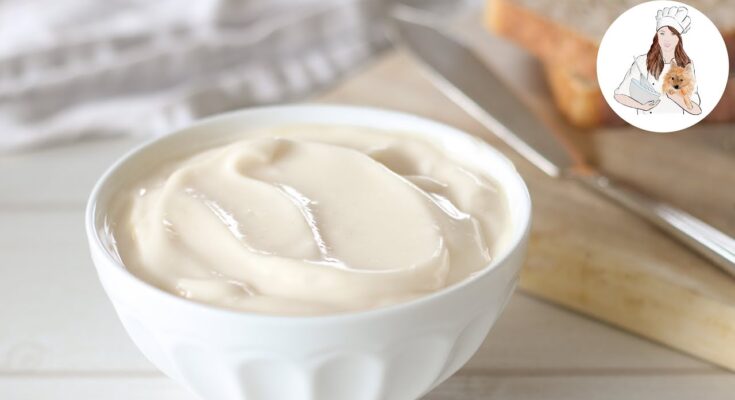Homemade Mayo Recipe: Mayonnaise is a staple condiment in many households, but did you know that making it at home is incredibly easy and rewarding? Unlike store-bought mayo, homemade mayonnaise is free from preservatives and artificial flavors, allowing you to customize the taste and texture to your liking.
By following this step-by-step guide, you’ll learn how to make creamy, rich, and flavorful mayo right in your kitchen using simple ingredients.
Ingredients Needed
To make homemade mayonnaise, you’ll need just a handful of basic ingredients:
Essential Ingredients:
- 1 egg yolk (room temperature)
- 1 cup of oil (see next section for the best choices)
- 1 teaspoon Dijon mustard
- 1 tablespoon lemon juice or vinegar
- 1/2 teaspoon salt
Optional Add-ins for Extra Flavor:
- 1 garlic clove (minced) – for garlic mayo
- 1 teaspoon honey – for a slightly sweet touch
- 1/2 teaspoon paprika or cayenne pepper – for a spicy kick
Tools Required
Best Tools for Making Mayo:
- Immersion blender – The easiest and most foolproof method
- Food processor – Great for making larger batches
- Whisk and bowl – Requires more effort but works well
Alternative Tools You Can Use:
- A standard blender
- A hand mixer
- A mason jar with a lid (for shake-mixing)
Choosing the Right Oil
The type of oil you use significantly affects the flavor and texture of your mayo.
Best Oils for Homemade Mayo:
- Light olive oil – Best for a mild flavor
- Avocado oil – Great for a healthier, creamy mayo
- Sunflower or grapeseed oil – Neutral in taste and good for a traditional mayo
Oils to Avoid:
- Extra virgin olive oil – Too strong in flavor
- Coconut oil – Solidifies at room temperature, making it unsuitable
Step-by-Step Instructions
Step 1: Preparing the Ingredients
- Ensure all ingredients are at room temperature.
- Separate the egg yolk from the egg white.
Step 2: Mixing the Base
- In a mixing bowl or blender, add the egg yolk, mustard, lemon juice (or vinegar), and salt.
- Whisk or blend until fully combined.
Step 3: Emulsification Process
- Slowly drizzle in the oil very gradually while whisking or blending constantly.
- Continue adding oil until the mixture thickens into a creamy consistency.
Step 4: Taste & Adjust
- Add extra lemon juice, mustard, or salt if needed.
- Mix well and enjoy!
Common Mistakes to Avoid:
- Pouring oil too quickly (prevents proper emulsification)
- Using cold ingredients (can cause mayo to separate)
Alternative Methods for Making Mayo
Homemade mayo can be made using different methods depending on the tools you have. While an immersion blender is the easiest way, you can also use a food processor, a regular blender, or even a whisk.
Using a Food Processor:
- Add the egg yolk, mustard, salt, and lemon juice to the processor.
- Turn the food processor on and slowly drizzle in the oil.
- Blend until the mayo thickens.
- Scrape the sides of the processor bowl if necessary and continue blending until smooth.
Using a Blender:
- Combine all ingredients except oil in the blender.
- Turn on at a low speed and slowly drizzle in the oil.
- Continue blending until you achieve a thick consistency.
Hand-Whisking Technique:
- Place the egg yolk, mustard, salt, and lemon juice in a mixing bowl.
- Whisk vigorously while adding oil drop by drop.
- As the mixture thickens, you can add oil more steadily while whisking continuously.
Troubleshooting Tips
Homemade mayo doesn’t always go perfectly, but here are common problems and how to fix them.
Why Your Mayo Isn’t Emulsifying:
- The oil was added too quickly.
- The egg yolk was too cold.
- The ingredients were not well-mixed before adding oil.
How to Fix Broken Mayo:
If your mayo separates or becomes too thin:
- In a clean bowl, whisk a fresh egg yolk with a teaspoon of mustard.
- Slowly add the broken mayo to the new yolk while whisking vigorously.
- Continue whisking until the mixture becomes thick and creamy again.
Flavor Variations & Customization
Once you master the basic mayo recipe, try adding different flavors for variety.
Garlic Mayo:
- Add 1 minced garlic clove or 1 teaspoon garlic powder.
Spicy Mayo:
- Stir in 1 teaspoon hot sauce or cayenne pepper.
Herb-Infused Mayo:
- Blend in fresh herbs like parsley, basil, or dill for a refreshing taste.
How to Store Homemade Mayo
Proper storage is key to keeping your homemade mayo fresh and safe to eat.
Best Storage Practices:
- Store mayo in an airtight container or a glass jar.
- Keep it in the refrigerator at all times.
Shelf Life & Spoilage Signs:
- Homemade mayo lasts for 5-7 days in the fridge.
- Spoilage signs: Sour smell, separation, or discoloration.
Using Homemade Mayo in Recipes
Homemade mayo isn’t just for sandwiches! Here are creative ways to use it:
Best Dishes to Pair with Mayo:
- Salads: Potato salad, coleslaw, tuna salad.
- Dips: Mix with ketchup for a fry sauce or with garlic for aioli.
- Marinades: Add to chicken or seafood for extra tenderness.
Creative Ways to Use Mayo:
- Spread on grilled cheese sandwiches for a crispy crust.
- Use in cake recipes for extra moisture.
- Mix with herbs for a delicious sandwich spread.
Health Benefits of Homemade Mayo
Homemade mayo is not only delicious but also healthier than store-bought versions.
Nutritional Value:
- Rich in healthy fats (if using the right oil).
- No preservatives or artificial additives.
- Good source of vitamins from egg yolk and oils.
How It Compares to Store-Bought Mayo:
| Feature | Homemade Mayo | Store-Bought Mayo |
|---|---|---|
| Ingredients | Natural & Fresh | Contains Preservatives |
| Shelf Life | 5-7 days | Months to a Year |
| Customization | Fully Customizable | Limited Flavors |
Common Mistakes to Avoid
Over-Blending:
- Blending for too long can make the mayo too thick or cause separation.
Wrong Ingredient Ratios:
- Too much oil makes the mayo greasy.
- Not enough acid (lemon juice or vinegar) results in a bland taste.
Making Mayo Without Eggs
For those who are allergic to eggs or prefer a vegan alternative, here’s how to make egg-free mayo.
Vegan Mayo Alternative:
Ingredients:
- 1/2 cup unsweetened soy milk
- 1 cup oil
- 1 tablespoon lemon juice
- 1 teaspoon Dijon mustard
- Salt to taste
Instructions:
- Blend soy milk, mustard, and lemon juice together.
- Slowly add oil while blending until thick.
Safety Tips for Homemade Mayo
Because homemade mayo contains raw egg yolk, safety is important.
Preventing Bacterial Growth:
- Always use fresh eggs from a trusted source.
- Store mayo immediately in the fridge after making.
Safe Handling Practices:
- Use a clean spoon each time you take mayo from the jar.
- Discard mayo if left at room temperature for over 2 hours.
FAQs about Homemade Mayo Recipe
1. What ingredients do I need for homemade mayo?
To make homemade mayo, you typically need basic ingredients such as egg yolks, oil (like vegetable or olive oil), lemon juice or vinegar, mustard, and a pinch of salt.
2. How long does it take to make mayo at home?
Making mayo at home usually takes about 10 to 15 minutes. Most of the time is spent slowly incorporating the oil into the egg yolks to ensure the mixture emulsifies properly.
3. Is homemade mayo safe to eat?
Yes, homemade mayo can be safe to eat if you handle and prepare the ingredients properly. To minimize the risk of salmonella, use pasteurized eggs and keep the mayo refrigerated.
4. How long can I store homemade mayo?
Homemade mayo can be stored in the refrigerator in an airtight container for up to one week. Always use clean utensils to scoop it out to prevent contamination.
5. Can I make mayo without eggs?
Yes, there are egg-free mayo recipes that use ingredients like aquafaba, the liquid from canned chickpeas, as an alternative to eggs. These variations are great for those who are allergic to eggs or follow a vegan diet.
6. What can I use homemade mayo for?
Homemade mayo is versatile and can be used in sandwiches, salads, dips, and as a base for various sauces and dressings.
7. How can I fix broken mayo?
If your mayo breaks or separates, you can try whisking in a tablespoon of hot water. If that doesn’t work, start with a new egg yolk in a separate bowl and slowly whisk the broken mayo into it.
Conclusion
Making homemade mayo is easier than most people think! With just a few simple ingredients and techniques, you can create a fresh, creamy, and delicious mayo customized to your taste. Plus, it’s healthier and free from preservatives.
Start experimenting today with different oils and flavors to find your perfect homemade mayo recipe!



